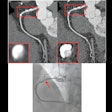Pancreatic carcinoma typically presents as a hypoenhanced focal mass during the late arterial or so-called pancreatic parenchyma phase, when normal pancreatic tissue enhances the most, explained Dr. Ralf Bauer, from Goethe University in Frankfurt, Germany, in an email. However, sometimes this hypoenhancement is very subtle and the tumor-to-pancreas contrast is very faint on standard polychromatic spectrum CT at 120 kV or 100 kV.
"This can give you a hard time; especially small lesions less than 2 cm may be missed," he said.
The study included 71 patients with suspected pancreatic adenocarcinoma, who underwent arterial-phase imaging with dual-source CT (Somatom Flash or Somatom Force, Siemens Healthcare). Image series were reconstructed with an updated monoenergetic software application (Monoenergetic Plus, Dual Energy, Siemens) for improved noise reduction, and the reconstructions were compared with virtual 120-kV series that blended spectral information from high- and low-kV datasets.
The idea of the study is to increase tumor-to-pancreas contrast by using monoenergetic-reconstructed dual-energy CT datasets acquired in the late arterial phase, Bauer explained.
"As the effective x-ray energy (keV) moves closer to the k-edge of iodinated contrast material (~33 keV), enhancement of the normally perfused pancreas increases much more than that of hypoperfused adenocarcinoma," he wrote in an email.
An improvement in the software can preserve low noise levels from higher kV acquisitions and combine low noise with the benefits of extrapolation to lower spectra closer to the k-edge of iodine, with resulting higher enhancement values.
"Higher enhancement with lower noise results in significantly increased tumor-to-pancreas contrast," Bauer noted.



















